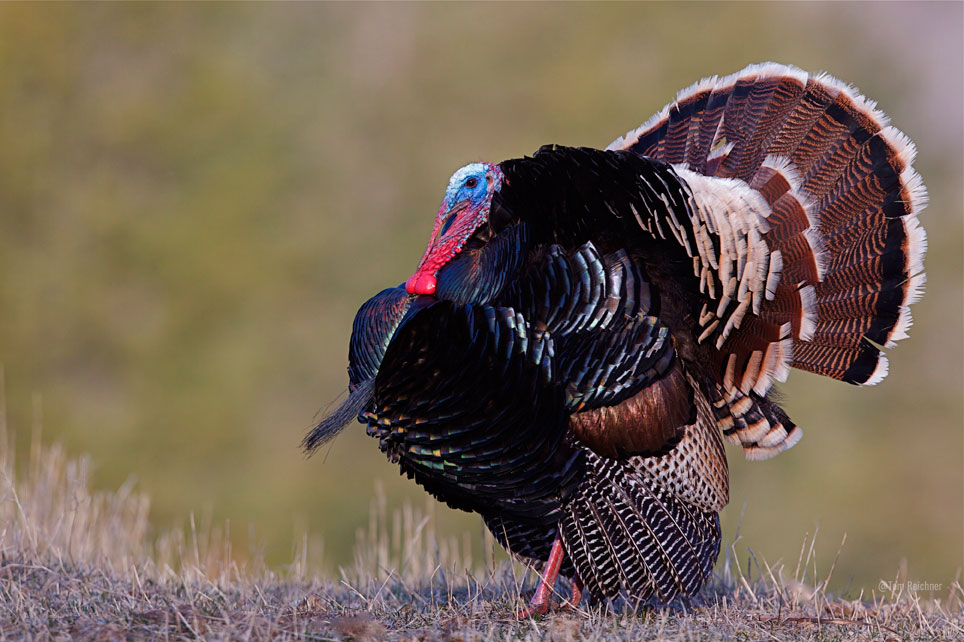Thanksgiving is just around the corner, and what better way to celebrate than by learning about one of its most iconic symbols—the turkey! Texas is a special place for these birds, as it’s home to three different kinds: the Rio Grande, Merriam’s, and Eastern. But did you know the Rio Grande turkey is the most common here? Let’s dive in and learn more.
The Three Subspecies of Turkeys in Texas
Texas is a diverse state, not just in its landscapes but also in its bird populations. Here, we’re fortunate to have three distinct subspecies of turkeys, each with its unique habitat and characteristics.
Rio Grande Turkey
These are the stars of the show in Texas. You can find them everywhere, from the Edwards Plateau to South Texas. There are about 500,000 to 700,000 of them in the state! They are distinguished by the tan tips of their tail feathers and tail coverts more high-pitched and warbly gobble.
Merriam’s Turkey
These turkeys like the mountainous areas of West Texas. They’re a bit rarer but still a sight to behold with their light buff-to-white tail band and coverts, showing more white than dark banding in the primaries and an even higher pitched and softer gobble than the Rio.
Eastern Turkey
Mostly found in East Texas, these turkeys love the forests and have red, featherless heads and iridescent coloring. They’re the least common due to habitat changes and unregulated harvest but still an essential part of our state’s wildlife. You can read more about Texas’ restoration program here.
Turkeys in Texas, particularly the Rio Grande subspecies, have unique characteristics that set them apart from their counterparts in other regions. While turkeys across America share many similarities, such as their general appearance and diet, the Rio Grande turkeys in Texas are known for their adaptability to arid conditions. Unlike Eastern or Merriam’s turkeys, which prefer more forested or mountainous habitats, Rio Grande turkeys are well-suited to the open plains of Texas. Their social behavior and lighter plumage also make them distinct.
Characteristics and Mating Patterns of Wild Turkeys in Texas
Habitat: Turkeys in Texas are unique for their adaptability to various habitats. The Rio Grande turkeys, for instance, require tall trees for roosting and good ground vegetation for nesting.
Nesting: They usually nest in a shallow depression on the ground lined with leaves and grasses. The clutch size ranges from 8 to 15 eggs, and the incubation lasts about 27 to 28 days. Young turkeys reach adult size by early fall.
Diets: Their diet varies throughout the year and may include insects, invertebrates, acorns, nuts, fruits, and seeds from grasses. They also forage in fields and pastures where insects and berries are abundant.
Texas Landowners & Turkeys: More Than Just a Holiday Feast
As a Texas landowner, you might already know that turkeys are more than just the centerpiece of a Thanksgiving meal. These birds are vital in maintaining a healthy ecosystem on your property. They’re natural insect controllers, feasting on bugs that could otherwise harm your crops and gardens. And let’s be honest, who doesn’t enjoy watching these majestic birds strut around?
Turkey Conservation: A Success Story in Texas
The thriving turkey population in Texas is no accident. It results from concerted conservation efforts that include controlled burns, food plots, and habitat management. These initiatives have been particularly beneficial for the Rio Grande turkey, the most common subspecies in the state.
Where to Spot Turkeys in Texas
If you’re keen to observe these fascinating birds, you’re in luck. Texas offers numerous opportunities for turkey-watching. Ideal locations include riverbanks, forests, and even some state parks. For the best chances, venture out early or late afternoon when they’re most active.
A Moment of Thanksgiving
So, as you gather around the table this holiday season, take a moment to appreciate the wild turkeys of Texas. They’re not just a delicious tradition; they’re a living testament to the rich biodiversity of our great state.
Other Birds We’ve Written About A Feathered Journey Through Texas
If you’ve enjoyed learning about the wild turkeys of Texas, you might also be interested in some of the other avian topics we’ve covered. From rare species to familiar backyard visitors, we’ve explored the fascinating world of birds in the Lone Star State.
- Rare Birds of Texas: The Montezuma Quail
- Types of Jay Birds in Texas
- How Do Birds Know Which Way to Migrate?









